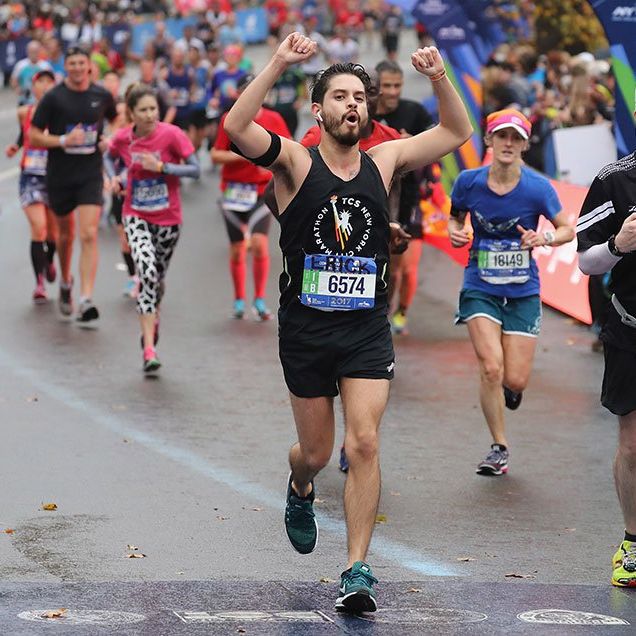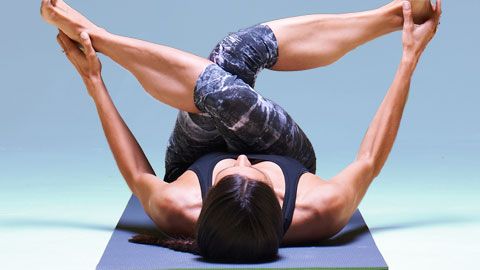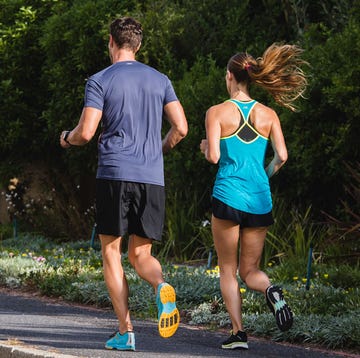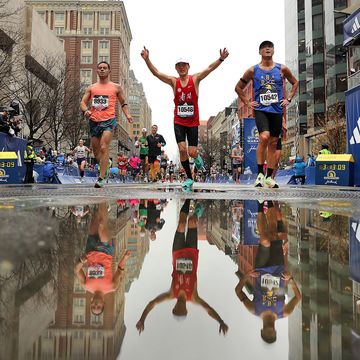Elizabeth Maiuolo wasn’t a runner when she moved to New York City 10 years ago. But she heard the marathon was the place to be, so she volunteered at the finish line, an experience that changed her life.
“You see people of all sizes, ages, and paces literally transform in front of you,” says Maiuolo, who eventually ran six New York City Marathons in a row and now coaches for New York Road Runners. “You totally feel inspired to think that can be you one day.”
Anyone with the word “marathon” in their vocabulary can target a 26.2-mile effort, provided they’re motivated and committed, says Chicago-area coach Denise Sauriol, who has helped hundreds of first-timers cross the finish line. Sauriol ran her first after watching her older sister finish one in 1993. “She turned what I thought was superhuman into human,” she says.
RELATED: 10 Big-City Marathons You’ll Love
Experts say a year is more than enough time for even brand new runners to prepare for their first marathon, provided they plan well. Here’s how:
Right Now
Choose your race. Scope out registration dates and policies; many big-city marathons limit entries and admit first-timers based on a lottery or drawing. Applications for the 2018 New York City Marathon are open from January 15 to February 15, while you can sign up for the 2018 Chicago Marathon now through November 30.
RELATED: New Qualifying Times Guarantee Entry to the 2018 Chicago Marathon
Assess your schedule. Consider how much time you have to train, advises Tim Bradley, a running coach in St. Louis. Ideally, you’d find slots for at least two to four shorter and one longer run each week, along with a day or two of cross-training.
Plot your strategy. Counting backward from race day, you’ll want four to six months for dedicated marathon training, Maiuolo says. But that doesn’t mean you should wait a half year to start running—use the weeks beforehand to safely ramp up to, and maintain, a consistent running routine. One way to do it: start with a training plan for new runners, then once you complete it, begin a marathon-training plan (for instance, the Runner’s World New Runner plan, then our First-Timers Marathon plan). You can also hire a coach or join a group tailored to your experience level. (Or get personalized race training for every distance with the new My Run Plan app from Runner’s World.)
Buy shoes. They’re the most important piece of equipment, Sauriol says. Visit a specialty running store (locate one with our Store Finder) for an expert fitting, along with advice on other gear, like GPS watches and cold-weather clothing.
Seek (more) inspiration. Fuel your fire with documentaries like Spirit of the Marathon and PBS’ Boston Marathon Challenge, both of which feature everyday athletes, Sauriol says. Signing up with a charity group to raise funds and awareness as you train can add meaning. A bonus: many offer support and guidance along the way.
In the First 3 Months
Find your joy. Making running fun helps you train consistently, Maiuolo says. Experiment with different situations and options to see what feels right for you—park versus treadmill, with training partners or alone, wearing headphones or tech-free.
RELATED: The Good Things That Happen When You Run Without Headphones
Slow down. If you start each training session at a sprint, you’ll swiftly fade. Ease your pace so you can hold a conversation during most runs—especially your long runs. You’ll build the aerobic fitness essential to successful marathoning, says elite runner and coach Neely Spence Gracey, who ran the 2016 NYC marathon in a time of 2:34.
Start a log. Use a website or app like Garmin or Strava, or write your mileage, time, and how you feel after each run down in a paper notebook. However you do it, tracking keeps you accountable and provides a solid record of your progress, Sauriol says.
Run a 5K (or two). Smaller goals stoke motivation along the way, and lining up two 5Ks a month or so apart can give you a read on how much you’re improving, Gracey says. Plus, shorter races give you low-stakes exposure to a race atmosphere. (Use our Race Finder tool to locate something near you.)
Hit the gym. One or two days a week of cross-training—think cycling, swimming, or group fitness classes—improve your fitness while giving your legs a break from the persistent pounding of running. And strength training makes your muscles and joints resilient against injuries, Bradley says. (You’ll love the short routines you can do immediately post-run with the RW 10-Minute Cross-Training workout.)
In Months 3-6
Run a 10K. Taking a step up in distance gives you even more experience fine-tuning your race-day routines.
Stay healthy and strong. As your mileage builds, use a foam roller to self-massage areas like your quads, hamstrings, and calves. Dynamic warmup moves and postrun stretches—Gracey, for instance, loves the Runner’s World 20-minute Yoga for Runners DVD—keep your muscles flexible and limber to prevent injuries.
Related video: Unknot your muscles with this routine.
Make travel plans. Unless you’re running your hometown race, nail down flights, hotels, and other big logistics.
Join a group. If you haven’t already, consider hooking up with other runners. Check online or at your local running store for meetups. Longer distances fly by faster when you’re chatting, and you’ll find yourself with a whole new group of friends who have similar goals, Sauriol says.
RELATED: How to Find Your Ideal Running Group
And connect virtually. Follow running-related social media accounts for ongoing inspiration and ideas, suggests Gracey, who’s on Instagram and Twitter @neelysgracey. (We’re on Instagram @runnersworldmag, Twitter @runnersworld, and Snapchat runners.world.) Here are 15 other social media accounts you’ll love following.
In Months 6-9
Fuel up. Once your long runs exceed 90 minutes, experiment with gels, chews, sports drinks, or other midrun carbohydrates. Post-run, grab a snack with a 4:1 ratio of carbs to protein to replenish the energy you’ve expended and start repairing damaged muscles.
Run a half marathon. If you don’t live in a big city already, consider trekking somewhere urban to get experience with the crowds and chaos of a larger field.
Nip budding injuries. See a sports-focused doctor, physical therapist, or chiropractor for any aches and pains that linger more than a few days or interfere with your gait, Gracey recommends.
Sleep well. Training is tiring. Everyone’s nightly needs differ, but you’ll probably find they increase along with your mileage, Maiuolo says.
Revisit your goals. You might have had a target finishing time in mind when you started training, but now you’ll have a better idea of what’s realistic. In most cases, first-time marathoners should focus on getting to the starting line healthy and finishing the race happy, Maiuolo recommends. But if your training and practice races have gone well so far, you might consider aiming for a specific time or pace.
In Month 9-Race Day
Do a dress rehearsal. Gracey recommends a final half marathon four to eight weeks before your goal race. Practice every element of your preparation, including what you’ll eat the night before, what you’ll wear, and how you’ll handle race-day nerves.
Review your log. One way to ease doubts and anxieties? Look back over how far you’ve come and remind yourself you’re ready for this, Bradley recommends.
Taper your training. In the two to three weeks before the race, your training plan will probably call for less mileage so you feel fresher on race day. Spend the extra time focusing on eating a high-quality diet, sleeping a little bit more, and visualizing yourself running strong and happy.
Make a race plan. Plot out the whole weekend, including when you’ll head to the expo, how you’ll get to the starting line, and where your cheering squad can see you along the way. If you’re traveling, stow your race-day outfit and nutrition in your carry-on. Consider taking throwaway clothes to wear and toss if the weather’s chilly, especially in New York, where you may have to wait outdoors for hours before the start.
Thank your supporters. Your friends and family have been patient as you complained about blisters, turned in early on Fridays, and spent hours logging miles on the weekends. And even if some expressed skepticism at first, rest assured they’ve noticed your transformation. “Everything you do, day in and day out, everyone around you is watching and starts to change, too,” Maiuolo says. “Somebody in the corner is starting to say, ‘Look, she’s doing it, so can I.’” By the time you cross the finish line, you just might find you’ve inspired someone else to take on the challenge next year.

Cindy is a freelance health and fitness writer, author, and podcaster who’s contributed regularly to Runner’s World since 2013. She’s the coauthor of both Breakthrough Women’s Running: Dream Big and Train Smart and Rebound: Train Your Mind to Bounce Back Stronger from Sports Injuries, a book about the psychology of sports injury from Bloomsbury Sport. Cindy specializes in covering injury prevention and recovery, everyday athletes accomplishing extraordinary things, and the active community in her beloved Chicago, where winter forges deep bonds between those brave enough to train through it.













